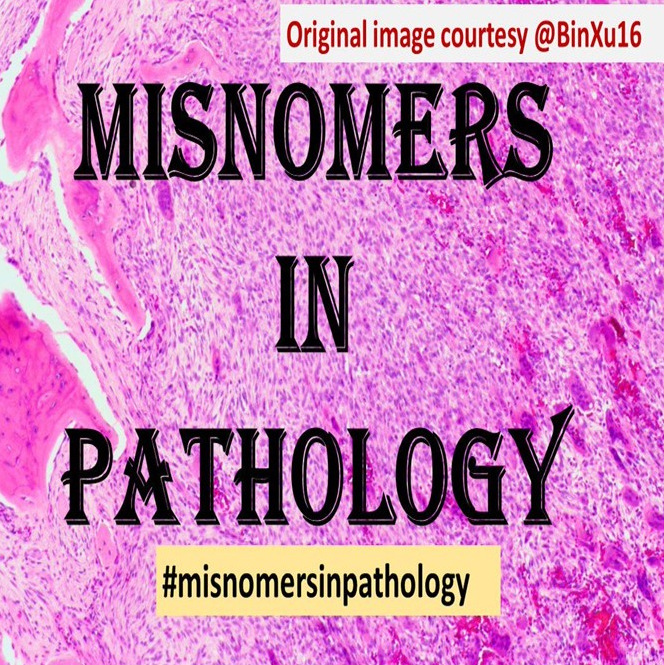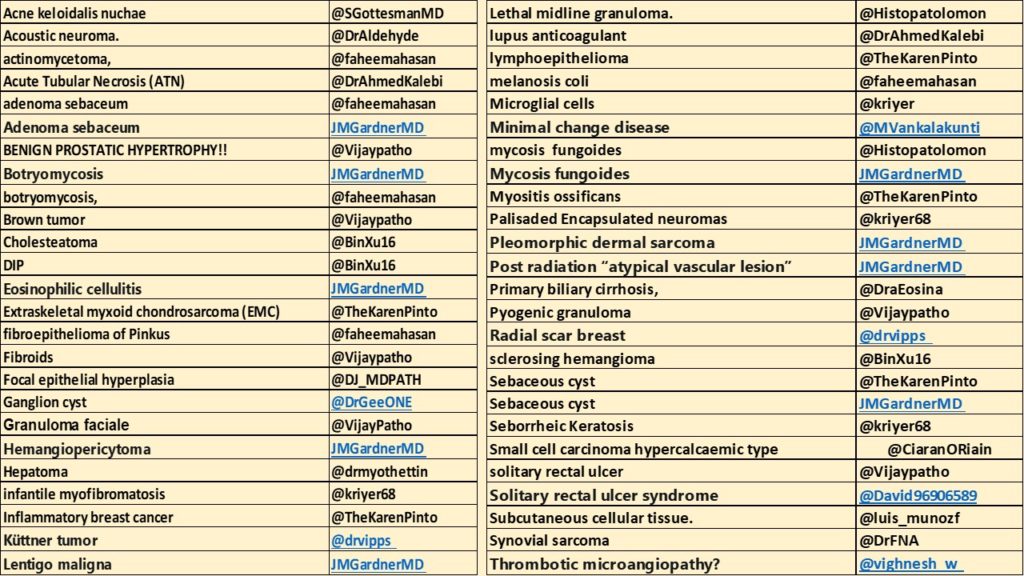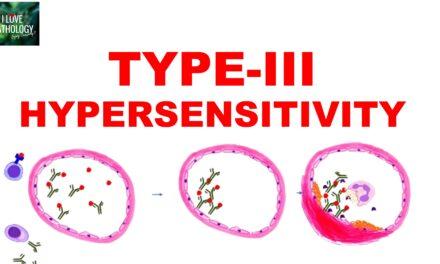Misnomers in Pathology. #misnomersinpathology
“Misnomer”
A misnomer is actually a name which does not suit what it refers to! It is derived from Anglo-French, noun use of Middle French mesnomer ‘to misname’, equivalent to mes- mis- + nomer -Latin nōmināre.
Misnomer in Pathology is basically an error in naming a lesion or a pathological finding. Some of these misnomers are due to inaccurate or vague translation from the origin of the words. Few of them are due to lack of understanding of the underlying mechanisms or their concepts.
For most of us, social media has become a part of routine in our lives. Of late there is rise in the use of these social media in learning Pathology thanks to Dr Jerad Gardner, who revolutionized the use of social media in Pathology Learning, particularly on twitter and Facebook. He is an associate professor in the University of Arkansas for Medical Sciences (UAMS) College of Medicine’s departments of pathology and dermatology. And today , there are Thousands of Pathologists on twitter who are enjoying learning and am happy that I am one of them!
During one such interaction on twitter, we came across a “Brown Tumor” which was a “misnomer”. Then, the hashtag #misnomersinpathology was created and shared on twitter, and the tweeple were asked to share all the misnomers they know, and were asked tag it with #misnomersinpathology. Within few days, more than 50 lesions were identified which were misnomers. I m sure many more would resurface.
I hereby have listed the ‘misnomers in pathology’ along with the twitter username of the tweeple who shared them. i am thankful to each one of the tweeple from whom, i have been learning and its fun too!
I have tried to explain few of the “misnomers in pathology”. If you know more , add them in the comment section below or share it on twitter and tag it with hashtag #misnomersinpathology
ACNE KELOIDALIS NUCHAE:
Acne keloidalis nuchae- not acne and rarely keloidal microscopically. This is a follicular based pustule or papule. They may appear like keloid or hypertrophic scar on clinical examination, however they are not on microscopic examination. Also these lesions do not occur due to acne vulgaris. This is a follicultic lesion. It has with free floating hair shafts and granulomatous inflammation
ACOUSTIC NEUROMA.
Does not derive from cochlear branch of CN VIII.It arises from tumor usually arises from the vestibular division of the vestibulocochlear nerve. The tumor derived from the Schwann cells of the associated nerve and not the neurons and hence not a neuroma. The correct name for this tumor is Vestibular Schwannoma.
ADENOMA SEBACEUM
It is a misnomer because, it is neither an adenoma nor derived from sebaceous glands. These are actually the facial angiofibromas which occurs as a skin manifestation of tuberous sclerosis
BOTRYOMYCOSIS
This is a rare chronic bacterial granulomatous disease which usually involves skin and rarely viscera. The name is a misnomer because it is not caused by a fungus but by a bacteria. The word “Botryo” is derived from Greek word “Botrys” meaning “bunch of grapes.” And the lesions used to resemble like the bunch of grapes and it was thought that it was caused by fungal organisms until the bacterial origin of this infection was discovered.
BROWN TUMOR
This is an osseous lesion that develops in bones affected by primary or secondary hyperparathyroidism. It is caused due to abnormal bone metabolism in patients with hyperparathyroidism. The brown hue is due to the abundant hemosiderin laden macrophages in this lesion and hence the name “brown” However Brown ‘tumor’ is a misnomer because it is NOT a tumor, rather it is a non neoplastic lesion and represent a reparative process.
FIBROIDS
It is a common term used for uterine leiomyomas. The term “fibroid” is really a misnomer because this tumor consists of smooth muscle rather than fibrous tissue
GANGLION CYST:
This is a misnomer because, it is unrelated to the word ganglion which is neural. Apart for that this is not even a true cyst as it does not have an epithelial or synovial lining and it is an extra-articular collection of fluid.
INFLAMMATORY BREAST CANCER
This is a variant of breast cancer which is associated with poor prognosis. Clinically it has a swollen, erythematous nad edematous presentation and hence the term inflammatory was used. It is a misnomer because, it is not associated with inflammation or infection. The skin changes(lymphedema) are not due to infection, but due to dermal tumor emboli.
KÜTTNER TUMOR
Sclerosing chronic sialoadenitis , NOT a neoplasm. This is an inflammatory condition which presents as a hard mass, hence it was considered to be a tumor! This has a clinical characteristics of a malignant tumor
LENTIGO MALIGNA
It is basically a melanoma in situ. It is a misnomer because it is not malignant nor it is just lentigo
LYMPHOEPITHELIOMA
This is the other name for nasopharyngeal carcinoma. This name is a misnomer because this tumor is purely epithelial in origin and the neoplastic cells are not lymphocytes. Some of these cases don’t even have lymphocytes!
LUPUS ANTICOAGULANT
which is actually associated with thrombosis (increased clotting) & not a test for lupus, something we have to remind clinicians now & then. Lupus anticoagulant is an immunoglobulin and is an antiphospholipid antibody.They are forund in normal individuals and in certain autoimmune diseases. The word itself is a misnomer because it is NOT an anticoagulant but a prothrombotic agent which causes paradoxical increase in the frequency of arterial and venous thrombotic events in patients having these! And they not necessarily be associated with lupus erythematosus always.
MYOSITIS OSSIFICANS
common injury associated with sports. This is a misnomer because there is no inflammation of the muscle (myositis) and ossification is not always present.Also it can occur in any type of soft tissue and not always muscle! It is basically a heterotrophic or dystrophic calcification and rarely ossification can be seen.
MELANOSIS COLI:
This is a disorder of pigmentation of the colonic wall which is caused by prolonged use of laxatives, and commonly anthraquinone containing laxatives such as senn and aloe vera. This is a misnomer because, the pigment present in the macrophages is lipofuschin and NOT melanin!
MYCOSIS FUNGOIDES
The term mycosis fungoides is a misnomer because it is not an infection caused by fungi , rather it is a type of non Hodgkin Lymphoma. It is a type of cutaneous T cell lymphoma.
PRIMARY BILIARY CIRRHOSIS
Primary biliary cirrhosis (PBC) is a chronic cholestatic liver disease, frequently developing in middle-aged women.
Patients were diagnosed as having PBC when 2 or more among the following 3 features are observed;
1.Elevated cholestatic enzymes,
2.Presence of anti-mitochondrial autoantibodies and
3.Histological finding of chronic non-suppurative destructive cholangitis
Hence the term primary biliary cirrhosis is a misnomer because, cirrhosis is not always evident and it it is always found at end stage. Primary biliary cholangitis would be the better terminology as suggested by Japanese Society of Gastroenterology and the Japan Society of Hepatology
PALISADED ENCAPSULATED NEUROMAS
Also known as solitary circumscribed neuroma. It is a misnomer because, it is not encapsulated. And there is no actual palisading. So the better term would be solitary circumscribed neuroma.
PYOGENIC GRANULOMA
Pyogenic granuloma is an inflammatory hyperplasia of the skin and oral mucosa which in histology is an angiomatous lesion. It is a misnomer because this is not associated with pus/pyogenic nor it is a granuloma!
RADIAL SCAR
This lesion in the breast is a stellate proliferation of the ducts and acini which surrounds a central fibrous and elastic tissue. This central area looks lika a scar. It is a misnomer because it is NOT RELATED TO TRAUMA! This lesion can mimic malignancy on mammogram. The other name for this lesion is Sclerosing duct lesion
SOLITARY RECTAL ULCER SYNDROME.
It is a misnomer because doesn’t have to be solitary, ulcerated or part of a syndrome. Also not necessarily be rectal in location. This is also called mucosal prolapse syndrome, which presents as Solitary or multiple ulcerated or polypoid lesions 4 – 10 cm from anal margin.
SMALL CELL CARCINOMA HYPERCALCAEMIC TYPE.
It is a misnomer because
Often not small cells ,No hypercalcaemia always ( hypercalcemis only in 2/3 of cases, and Not a carcinoma( as there is no proof that it is of epithelial origin)
Recently it is found that malignant rhabdoid tumor is the better term.
SEBACEOUS CYSTS
The most commonly used word is actually a misnomer because they are not derived of sebaceous origin. Instead these are epidermoid or pilar cysts.
SYNOVIAL SARCOMA
It is a rare soft tissue sarcoma most often occurs in children and young adults. It is a misnomer because it is not derived from synovium, nor does it differentiate into synovial-type tissue. It was once considered as synovial sarcoma probably because of its propensity to originate in periarticular regions and rarely it resembles the histology of synovium specially in biphasic types. It is now postulated that this sarcoma arises from pluripotent mesenchymal tissue.






